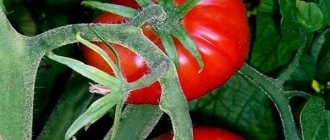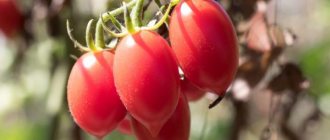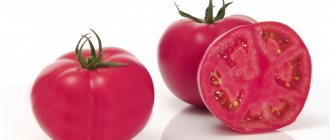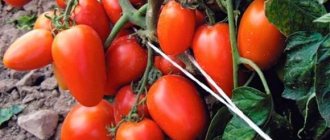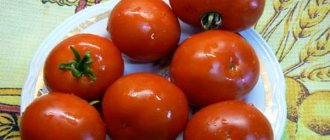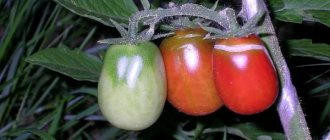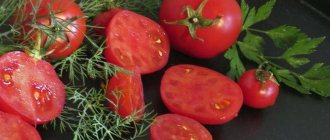How to grow seedlings?
It is recommended to plant Pineapple tomatoes by growing seedlings and then planting them in open ground. In order to independently obtain seedlings, it is necessary to observe the sowing time, the conditions for preparing and sowing seeds, select the correct substrate for cultivation, and then create the necessary conditions for germination and growth of seedlings.
Time for sowing
It is recommended to plant seeds in prepared soil in early March and no later than early April.
Soil mixture
The homemade substrate in which tomato seeds will be planted should consist of the following components:
- land from the place where it is planned to grow the crop in the future: from a greenhouse or open ground;
- peat;
- river sand, washed;
- wood ash.
You can also purchase a suitable soil mixture for growing tomatoes at a specialty store. Before planting seeds, experts recommend treating the soil in order to disinfect it and protect the seedlings from infection with characteristic diseases, thereby ensuring good conditions for growing seedlings.
To do this, use a low concentration solution of potassium permanganate. To improve the conditions for seed germination and obtain faster seedlings, you can treat the soil with growth stimulating preparations.
The optimal solution for growing seedlings is containers. They are filled with suitable soil and seeds are planted in the prepared grooves. Subsequently, the seedlings are planted in separate cups.
Seed preparation
The seed preparation process is as follows:
- in order to exclude possible diseases, the seeds are dipped in a weak solution of potassium permanganate;
- To ensure good and quick germination, the seeds are wrapped in a wet cloth, cotton wool or gauze soaked in a growth stimulant and sent to a warm place.
In this case, it is necessary to ensure that the fabric is damp all the time.
Sowing seeds
It is necessary to make grooves in the soil 1–1.5 cm deep, into which the seeds are placed at a distance of 2 cm. The distance between the grooves should be about 4 cm. After immersing the seed, it is covered with a thin layer of soil and irrigated with a spray bottle.
Seedling care
After planting the seeds, they need to create favorable conditions for rapid germination and good seedling growth.
For this, experts recommend:
- Send the box with seedlings to a warm place with good lighting and cover with glass or plastic wrap.
- The room temperature should be within 25... 27°C until germination. After emergence of seedlings, the temperature should drop slightly and be at 17... 20°C.
- For successful seedling growth, daylight hours must be long, about 12 hours a day. If necessary, you can use additional lighting; it is better to use a phytolamp as a lighting device.
- The soil should be moistened as the soil dries, irrigating it with a spray bottle.
- When the seedlings grow and 2 true leaves appear on them, it is recommended to plant them, planting each bush in a separate container. It is convenient to use small plastic cups for these purposes.
- It is recommended to fertilize the box with seedlings according to the diagram and manufacturer’s recommendations. After picking, it is recommended to add a rooting fertilizer to the soil along with watering, which will promote good development of the root system. When the seedlings have 5 true leaves, the plants are watered with an insecticide solution to protect them from pests.
The hardening procedure begins a week before the planned time of planting seedlings in open ground. It is carried out so that young bushes get used to new growing conditions and adapt better after transplantation.
The seedlings are hardened by exposing the glasses with seedlings to fresh air for several hours every day. In this case, you should avoid direct sunlight on the young plant, as it may suffer from this. Gradually the duration of the “walk” is increased.
Planting seedlings in open ground is carried out after gradual hardening and adaptation to growing conditions in the natural environment. It is not recommended to plant Pineapple tomatoes in heaps and thicken the planting, since the bushes are tall.
Deadlines
Seedlings should be planted in open ground only after the danger of night frosts has passed and the soil has warmed up sufficiently. Since the Pineapple tomato is a mid-season variety, seedlings should be planted no earlier than mid-May, provided that the soil has warmed up to a temperature of 15... 18°C.
Selecting a location
The place for growing tomatoes should be well lit. The arrangement of the rows of tomatoes should be such that the bushes are well blown by the wind and there is no accumulation of moisture or morning dew, which will help protect the plants from many diseases. When planting tomatoes, you should also consider crop rotation.
It is not recommended to plant tomatoes after nightshades:
- potatoes;
- sweet pepper.
Planting scheme
When planting seedlings in open ground, you must remember that the bushes of the Pineapple variety are tall, so they are planted in accordance with the scheme of 2–3 bushes/1 m². It is imperative to install a trellis support along which the bush will subsequently climb and to which it can be tied.
Tomatoes are delicious and beloved vegetables by many. They come in different sizes, large and small, meaty and juicy. And most importantly, they are easy to grow.
To grow seedlings you need:
- Prepare the seeds.
- Select a container and prepare the soil.
- Sow change.
- Grow seedlings.
- Provide her with proper care.
Let's consider each of the points separately.
Seed preparation
So that your efforts when planting seeds are not in vain, you need to carefully sort them out. To speed up the sifting process, place them in a container of salt water.
Water is diluted as follows: 1 tablespoon per glass of water. After 10 minutes, bad seeds will float, and good ones will fall to the bottom.
After selecting the seeds, they need to be prepared for planting:
- Disinfection will protect the plant from diseases. For this:
- The seeds should be left in a 0.8% solution of vinegar or for a third of an hour in a weak solution of manganese.
- After the procedure, carefully rinse the seeds with running water and dry.
- Warming up the seeds is done if they have been in a cold place for a long time. Warm them up as follows:
- Or leave it near the battery for 2-3 days.
- Or for several hours in a thermos with hot water. After this it is dried.
- Hardening helps young shoots adapt to different environmental conditions.
- Take a piece of cloth, place the seeds on one half, cover the other half on top, place it on a saucer, pour in a little water and leave it in the room for one day.
- On the second day, place the plate with seeds on the bottom shelf of the refrigerator for 24 hours.
- Repeat the procedure a day later.
All these procedures are needed to prepare the future plant for various environmental changes and improve productivity.
Container and soil
Before planting seeds, you need to prepare the soil and container for planting. Choose a large container to plant all the seeds at once.
When the tomatoes sprout, they are already seated in separate cups.
If for some reason you do not have the opportunity to prepare the mixture yourself, then you can purchase it at a specialized store. Seeds are planted 1.5-2 months before transplanting seedlings to a garden bed or greenhouse.
If you do this ahead of schedule, the sprouts will not have time to grow stronger and will die. And if you delay this process, they will stretch out and replanting will be inconvenient.
Sowing:
- Pour the soil mixture into the prepared container and lightly compact it.
- We water the finished soil and cover it with film overnight.
- The next day, the soil must be leveled and grooves made for sowing at a distance of about 4 cm from each other, the depth of the hole is 1 cm.
- Pour the seeds evenly into the prepared holes, sprinkle them with soil and water them.
- Cover the container with film and place it on the window.
- After a week, the film must be removed and the container moved to a room where the temperature is up to 16 degrees.
- After another week, the container with the seedlings must be returned to the windowsill and the sprouts should be provided with a temperature regime of up to 24 degrees during the day and up to 12 degrees at night.
The main thing in caring for tomatoes is to properly provide and maintain certain environmental factors at the required level. Such as:
- humidity;
- temperature;
- Fresh air;
- lighting.
Let's look at all the factors and necessary conditions in more detail:
- Watering. Until the seeds sprout their first shoots, soil moisture must be checked every day. If the soil is dry, moisten it with a spray bottle.
Important! Never water the soil with seeds without a special device, otherwise you may wash the seeds out of the soil.Water with warm water, second watering after a week. But monitor the soil moisture every day. If it dries out, the sprout will die. The plant is watered with a pipette at the root, without getting on the leaves.
- Lighting. For seedlings, choose the brightest place in the room. Most often this is a window sill. In addition to natural light, the plant will also need artificial light, which can be organized using a lamp. The plant must be illuminated at least 14 hours a day.
- Temperature. For the sprouts to sprout, the room temperature must be from 25 to 28 degrees. After a week, the temperature can be lowered to 20-25 degrees. And in another two weeks - up to room temperature.
- Ventilation and humidity. While the seeds are under the film, the container should be lifted and moisture removed so that mold does not appear due to excess moisture. If mold does appear, remove the affected soil and water the soil with a solution of potassium permanganate. The film can be removed only after 1-2 weeks after shoots To prevent this from causing injury to the plant, the film should be opened briefly every day.
- Fertilizer. After the first sprouts have appeared, at least 10-14 days must pass before the first complementary feeding. After this, the plant is fertilized every week. Fertilizers are introduced when the sprouts produce their first leaves with teeth. After the tomato sprouts produce their first true leaves, they need to be pruned.
Reference! Picking is the procedure of transplanting a plant from a common container into an individual pot or glass no smaller than 10x10 in size.During the picking process, all sick and weak plants are eliminated. When picking, the seedlings are transplanted deeply, the stem is buried right up to the leaves.
Features of cultivation
The Pineapple tomato belongs to the mid-early varieties, therefore, to obtain an earlier harvest, seeds begin to be sown at the end of March or beginning of April. The pre-seed material is placed in well-moistened gauze or a cloth and left for a couple of days in a warm room. Periodically check that the gauze is damp.
Leave 4 cm between the rows. Cover the crops with a thin layer of soil on top and moisten it, if necessary, with a spray bottle. The container is placed in a well-lit, warm room and wait for seedlings to emerge. As soon as the first sprouts of the Pineapple tomato begin to appear, the room temperature is reduced to 17–18 °C.
Daylight hours for seedlings should last 12 hours. If planting was done early, additional lighting may be required using a special phytolamp. As the soil dries, it is moistened by spraying from a spray bottle. A week before planting in open ground, Pineapple tomatoes begin to harden. To do this, they are taken out into the open air for several hours. Avoid exposure to direct sunlight, which can cause burns.
After preliminary hardening, young plants are planted in a permanent place of growth. Pineapple is a tall tomato, so it is better not to thicken its plantings. 3-4 bushes are placed on one square meter. Supports or trellises are installed in advance to which the tomatoes will be tied. Watering should be moderate to prevent overwatering.
With proper care, the Pineapple tomato will delight you with a bountiful harvest until autumn. Its peculiarity is that the taste of the fruit does not deteriorate by the end of the season, like most other varieties, but, on the contrary, improves. Numerous enthusiastic reviews from summer residents once again confirm this.
For the most favorable growing conditions it is necessary:
- When planting seedlings in the ground, add 1 tbsp to each hole. a spoonful of superphosphate mixed with potassium sulfate
- Do not water frequently, but only when the soil dries out
- When forming a plant into 2-3 stems, leave 3-4 brushes on each stem
- Remove old leaves in a timely manner
Pineapples are resistant to diseases, but summer residents note that prevention is still necessary. Spray with a baking soda solution and your vegetables will delight you day after day.
It is advisable to apply mineral fertilizers two to three times a month to promote favorable growth. Avoid direct sunlight on plants.
Two to three days before the planned transplantation, it is necessary to water the seedlings abundantly.
In the first week after transplanting into the greenhouse, ensure daily watering of the soil, and after two weeks you can carefully loosen the soil for the first time.
Medium early/Tall
User rating: 5/5
Mid-season / Tall
User rating: 5/5
Mid-season / Tall
Taste qualities
The taste is sweet, the flesh is soft. Good for salads due to its low acid content. The juices have a slight aroma of spices, which allows them to be used both for drinking and cooking. The fruits contain virtually no seeds.
Tomatoes contain a large amount of lycopene (an antioxidant and pigment), which makes them a kind of therapeutic and prophylactic agent.
Early maturing / Tall
User rating: 5/5
Mid-season / Tall
User rating: 5/5
Early maturing / Tall
The tomato has a sweet citrus taste and amazing aroma. Suitable for eating raw, making salads or various snacks. Black Pineapple combines the best of green and dark-fruited tomatoes. The shape of the tomatoes is flat-round with slight porosity. The skin of a ripe tomato is dense and does not crack. Color - brownish with a purple tint.
The tomato pulp is sugary, practically without seeds. The pulp does not have a single color - it can be pink, red, green or yellow.
To obtain a dark skin color, breeders crossed wild tomatoes with red varieties. Then the darkest-colored hybrids were selected for further selection.
Planting and care
After checking the germination of biotechnology seeds, we plant them in special pots. Do not forget to water regularly and periodically expose to the sun. Planting in the ground is recommended according to the scheme 50*40 centimeters, 3-4 plants per 1 sq.m.
Since our plant grows 1.5-2 meters high, it is necessary to install special pegs or rods with each hole to which the tomatoes will be tied. It is necessary to tie it very carefully so as not to damage the hands.
Don’t forget to carry out stepsoning, don’t delay it, because stepsons draw nutrients and moisture from the main stem, which significantly reduces the yield.
Remove the stepchildren when they have not reached 5 centimeters, leaving a small stump.
Early maturing / Medium growing
User rating: 4.7/5
Late-maturing / Medium-growing
User rating: 5/5
Medium early / Medium height
Features of cultivation and possible difficulties
The Pineapple tomato is a mid-season variety: to get an earlier harvest, the seeds need to be planted at the end of March or beginning of April.
About 7 days before planting the Pineapple tomato, you need to start hardening the plant. To do this, they are taken out into the fresh air. Every day, the time spent in the open air is increased; on days 3-4, they are left in the air overnight.
When planting a tomato in open ground, do not forget that the plant is tall and there should not be more than 2-3 bushes per square meter.
You should water the tomatoes carefully and moderately, otherwise fungus may not only develop in the soil, but the roots will also begin to rot. Plants are fertilized once every two weeks. If you properly care for your tomatoes, they will delight you with a bountiful harvest until autumn.
Difficulties in growing tomatoes can arise in a variety of ways:
- Seedlings that grow on a windowsill become pampered under favorable conditions and will not easily adapt when transplanted. To avoid this, harden off the seedlings.
- The leaves of seedlings turn yellow and dry out - these are the consequences of a lack of light or excess moisture.
- The plants do not have enough light due to the plants being planted too close, and they begin to stretch towards the light.
- If the leaves are limp and drooping, the plant does not have enough moisture.
- If white spots appear on the leaves of a tomato, they are sunburned, but brown spots indicate a fungal disease.
To overcome all these difficulties, it is enough to carefully examine the plants and follow the basic rules of caring for them.
Diseases and pests
Diseases and pests affect growth and yield. There are several problems that can be identified by appearance. All diseases, except fungal ones, can be prevented or cured by feeding the plant with one fertilizer or another.
But the spread of mold on a plant threatens you with the loss of the entire bush and infection of neighboring ones. This happens because the fungus spreads quickly.
But there are several more dangerous diseases and pests that you need to know about:
- Blooming rot on the back of the fruit. It is easy to recognize: a dark-colored spot the size of a two-ruble coin appears on the back of the fruit. You can get rid of the disease by removing the affected fruits. To prevent a recurrence of the disease, you need to monitor watering and fertilize the plant with calcium (some gardeners use crushed eggshells as a top dressing).
- The flowers begin to set, but fall off and the fruit either does not have time to develop at all or is very poorly developed. This often happens due to sudden changes in the weather, for example: during the day the temperature was above 35 degrees, and at night it dropped to 10. Mulching will help to avoid the problem.
- Sticky and deformed leaves. The cause is the pear-shaped aphid. It causes damage to the plant by sucking the juice out of it and leaving behind a sticky substance on the leaves and fruits. In addition to aphids, whiteflies and spider mites can cause the same visible symptoms. Special insecticidal sprays and removing weeds around the plant will help get rid of pests.
- Cracking of fruit skin. Cracks may appear due to accelerated growth caused by increased humidity, for example: rain after a long drought. Another reason may be banal overripeness of the fetus.
- Formation of black-brown spots on leaves. The cause of these symptoms is a fungus that survived on old plants and transferred to new ones. To cure the plant, you will need to purchase special aerosols and remove all old plants from your garden.
- Nematodes. The bad news is that the plant cannot be cured of this scourge. Good - despite this, the plant is capable of producing edible fruits. To prevent new plants from getting sick, plant marigolds next to the garden bed; they release chemicals that kill nematodes.
History and characteristics of the variety
This two-color tomato variety appeared thanks to the efforts of American breeders and was called Bi-color Pineapple Tomato. A special feature of this crop is its attractive, juicy and bright yellow color on the outside, while the pulp in the middle of the fruit has a richer orange color and smoothly turns yellow towards the edge. This tomato variety has gained popularity due to its interesting taste with sweet notes, which is why it got its name.
Did you know? The yellow color of Pineapple tomatoes indicates that they contain a large amount of vitamin A - a source of carotene, which promotes good skin condition, removes toxins and improves vision.
Gardeners fell in love with the variety for its long-term fruiting. Pineapple tomatoes are often used fresh for preparing salads and seasonal vegetable platters. The variety can be processed for the preparation of sauces and adjika; it is rarely used for preservation, since the fruits are large in size. Tomatoes are grown in southern regions with a lot of sunny and warm days, in open ground, and in cooler regions - in high greenhouses.
The variety is mid-season, indeterminate, ripening within 120–130 days. The bushes reach 1.5–2 m and are tall. The bush is formed into 3 stems. The first inflorescence is formed above the 8–9 leaves, each cluster of the bush has 5–6 tomatoes. Pineapple fruits are very large, can reach 900 g, but the average weight of tomatoes is 250–300 g. The taste is sweet, with a slight hint of citrus and fruity notes.
The aroma and taste of tomatoes improve towards the end of the season. The pulp has a dense structure, with a small number of seed chambers. The color of the pulp has two colors: a more saturated orange color in the center of the fruit, changing to a lighter, yellow color towards the edges. The variety is resistant to most tomato diseases.
Important! The appearance of the ripe fruit resembles the fruit of the same name, since the tomato skin has light yellow ribs reminiscent of pineapple scales.
It should also be said that the series of tomatoes with an unusual flesh color of two or three colors also includes the following varieties:
- Hawaiian pineapple is a large orange fruit with a pronounced pineapple flavor, sweet, weighing up to 700 g.
- Golden pineapple - yellow fruits with orange stripes in cross-section have an orange color with pink veins, are sweet, the taste is similar to pineapple. The average fruit size is 300–400 g, and can reach 1 kg.
- Black pineapple is a variety of Belgian selection; the fruits have a citrus taste and a tricolor color. The tomatoes are sweet, practically without seeds, round and slightly flattened, with ribs, average weight - 700 g. The color of tomatoes is always different and can be green, olive, black, yellow, red, orange and burgundy. The tricolor color is preserved inside the fruit.
Advantages and disadvantages
- The variety has a large number of positive characteristics, which include:
- early and mid-early ripening;
- long fruiting (in warm regions the fruiting season can last until September);
- good yield;
- attractive appearance of tomatoes;
- interesting, sweet taste, which becomes more pronounced towards the end of the season;
- large fruit size;
- good transportability (does not crack when transported over long distances);
- does not require much effort during the growing process, unpretentious to the conditions;
- can be grown in open ground and high greenhouses;
- has an attractive presentation.
Pineapple tomatoes are often used in children's and diet menus. Experts and experienced gardeners agree that the variety has virtually no negative characteristics. However, tomato bushes require mandatory pinching and staking.
Description of the variety
The Pineapple tomato is an early-ripening indeterminate species. The bushes of the plant are tall and need staking. The average height of adult shoots reaches 1.5 meters. The tomato is considered a large-fruited variety; on average, the weight of one vegetable is 250 grams. With proper care and proper removal of stepsons, it is possible to obtain giant vegetables.
The fruits are characterized by a sweetish taste, unusual for tomatoes. Reviews from gardeners note pineapple notes, which are more typical of fruit. The pulp of tomatoes is dense, but lends itself well to cutting. Due to its large size, the variety is suitable for salads and use in winter recipes.
How to care outdoors
When growing any plant there are certain nuances that must be taken into account.
The nuances of growing Pineapple tomatoes in open ground and in a greenhouse:
- Wrong choice of landing site. Choose a sunny area where nightshades have not been planted before.
- Growing different crops together. For example: cucumbers and tomatoes cannot be planted in the same greenhouse, since they need completely different climatic conditions.
- Incorrect formation of tomatoes. Sometimes gardeners feel sorry for removing side shoots, or they forget to pinch the tops in time. The bush grows lush and weighty, but, unfortunately, does not bear fruit. A plant that is planted in open ground should not have more than 4 stems.
- Stem constriction. When gartering tomatoes, you need to be extremely careful not to damage the stem.
- Late stepsoning. If the side shoots are not removed in time, the yield will suffer. They need to be removed at a size of 3-4 cm, since they consume all the nutrients and do not allow the plant to develop.
- Eating disorder. Sometimes gardeners get carried away with feeding the plant and, instead of a large harvest, end up with a lush bush with large, strong leaves. This is due to the large amount of manure.
- Closed greenhouse. If the greenhouse has high humidity and temperature, it should not be closed. In tomatoes, pollen grains stick together and normal pollination does not occur, which means the plant bears fruit worse.
- Late processing. Tomatoes growing in a greenhouse should be treated with biological products once every two weeks or after each harvest.
The Pineapple variety is easy to care for, but to get a good and tasty harvest, you must follow some recommendations.
Watering
The soil should not be too wet to prevent diseases of the root system, so watering should be done as the soil dries, every 5-7 days. The main thing: do not allow the soil to dry out during the period of setting tomatoes and their ripening.
Feeding
When ovaries begin to appear on the bush and future tomatoes are formed, the plant definitely needs additional feeding. To do this, complex mineral fertilizers are applied to the bush along with watering.
Important! The application of fresh manure should be avoided, as this is a very active fertilizer that can harm young tomato bushes.
You can also use organic fertilizers. Regular application of mineral complexes should occur once every two weeks.
Stepsoning
For indeterminate varieties, the pinching procedure is integral, since it helps the plant to ensure effective formation of ovaries and good development of fruits. Removing side shoots accumulates the strength of the bush and it produces a harvest with large fruits.
Soil care
Tomatoes love loose soil, so it is necessary to control its condition. To improve soil aeration, regular loosening should be carried out, which will allow the root system to receive more air, which means the plant will develop well. Removing weeds will allow the bushes to receive nutrients from the soil in full.
Tomato bushes of this variety require the formation of a stem. They can be grown in 1, 2 or 3 stems. The last option is the most optimal. The stem is tied to a support or trellis during the growth process. This allows the plant to fully develop, receive more solar heat and be well ventilated, preventing moisture accumulation.
Since the bush is tall, it is recommended to pinch it at the level of the 14th–15th leaf, which will allow the plant to accumulate strength for fruiting.
This variety practically does not suffer from diseases typical of tomatoes. However, it is worth remembering that the organization of improper growing conditions, the accumulation of moisture on the foliage, without proper air exchange, as well as increased soil moisture can lead to the following diseases:
- gray rot;
- root rot;
- spotted wilt;
- mildew.
In order to prevent diseases, it is recommended to spray the bushes with a soda solution (250 g per 10 liters of water), and also not to forget about the rules of agricultural technology.
Farmer reviews
Reviews left by farmers after growing and eating Pineapple tomatoes:
- Victor, Taganrog: “A good variety that ripens earlier than others. Does not require special care, everything is according to the standard scheme, watering, feeding, etc. The only drawback is that the bushes need to be tied up, otherwise they break or fall.”
- Valeria, Volgograd: “I recommend the Pineapple tomato variety to those who sell vegetables or like to eat them. The vegetables grow well and don’t get sick, but our family didn’t need their high yield, since we can’t eat a lot, and I don’t use them for pickling because of the color. Therefore, one bag of seeds is enough for one bed.”
- Sergey, Ivanovo: “The variety is good, but those who have not planted it before will have to get used to the different taste qualities. And so there are no more complaints. The yield is high, it bears fruit all summer, just have time to collect. The main thing is not to forget to pick and tie up the bushes in time, as they grow very wildly. If planted in a greenhouse, the bush can grow up to 2 m.”
Tomatoes of the Pineapple variety are an unpretentious plant that will not cause you much trouble, positive in terms of cultivation, yield and consumption. It can be planted both in open ground and in a greenhouse. Bush formation and pinching are required.
Speaking about this variety of tomato, gardeners note: the yield will be higher if you feed not only adult bushes, but also seedlings. A complex fertilizer for seedlings of tomatoes and peppers is suitable for this. The variety is quite unpretentious and does not require any special care. The only peculiarity is the need to tie up the bushes.
The tomato is not afraid of the main diseases of the nightshade family and pest attacks. Summer residents recommend planting the pineapple variety on their plots to those who either consume tomatoes in large quantities or sell them. The fact is that the yield of the variety is very high: it will not be possible to preserve them, and there are too many of them for homemade salads and tomato paste.
Productivity
Tomatoes of the Pineapple variety are harvested after the fruits have fully ripened. The plant is a mid-ripening variety, so the risk of fruits not ripening before the end of the growing season is minimized.
Tomato variety Pineapple is consumed:
- fresh;
- in salads;
- first and second courses.
Tomatoes are also well suited for whole-fruit canning.
Fruit harvesting begins when the tomatoes reach the so-called blanche ripeness - at this time the yellow color of the tomatoes becomes saturated, beginning to turn into brownish shades. At this moment, the taste of tomatoes becomes most vivid.
Did you know? Tomatoes are rich in vitamin C, but its concentration decreases significantly during long-term storage.
The yield of a bush can be up to 30 kg of fruit per season, since up to 40 clusters are formed on each plant. The plant begins to bear fruit on average 4 months after germination and does so until the beginning of autumn in warm regions when grown in open ground.
Tomatoes are used mainly for fresh consumption and for making salads.
This variety is widely used by many summer residents. It is considered indeterminate and grows to a height of more than 2 meters, which causes significant inconvenience. Due to a significant increase in growth, the fruits require constant care, tying, picking and creating bushes. The basis for choosing a pineapple variety is its high yield and distinctive resistance to major diseases.
With proper care, the fruit grows up to 0.7 kilograms.
Advantages of the variety
In addition to its taste benefits, the Pineapple tomato can please gardeners with its resistance to a number of diseases and, in general, its unpretentiousness. Also, many gardeners note that these tomatoes are resistant to transportation, but are not stored for very long - up to 2-3 weeks. Therefore, it is better to immediately find a use for them. These tomatoes, having excellent taste, are well suited for salads and preparations - ketchups and sauces.
Being a representative of yellow tomatoes, Pineapple is filled with many useful substances. In addition, the microelements contained in yellow tomatoes are complementary.
Description and characteristics of the tomato variety Black Pineapple, reviews, photos
Pineapple tomatoes have several varieties:
- Black pineapple comes from Belgium. The fruit is colored in three colors: yellow, burgundy and orange. Despite its excellent taste, it is not suitable for winter preparations. The weight of one reaches 700 g.
- The golden pineapple has a golden color with a pink cap. It also has excellent taste. Suitable for eating raw and for preparations. Fruit weight 200-600 g.
- Hawaiian pineapple is orange in color, the fruits are large, the weight of one can reach 700 g.
- Tomato Beefsteak pineapple, one fruit weighs about 300 g. It has a bright red color.
All of them are approximately similar in their taste, resistant to diseases and pests.
The original name of the tomato is Black Pineapples.
Indeterminate, mid-season, exotic tomato variety. The height of the bush is 1.3-1.5 meters. Requires tying to the support and pinning. The best result was obtained when the plant was formed into 2-3 stems.
photo author Lydia Ganzen
The fruits are flat-round, very large, weighing up to 500 grams, fleshy, excellent taste and unique color: greenish-brown on the outside, pink-red-green-yellow flesh! Moreover, each tomato has its own unique pattern inside.
If you have grown Black Pineapple tomatoes, please leave feedback about them in the comments. Briefly describe the advantages and disadvantages of this tomato in your opinion. If possible, post a photo of these tomatoes. Thank you!
This is a natural variety of tomato. Therefore, we recommend taking seeds from a ripe fruit and growing them again next season!
Advantages and disadvantages
Pros:
- Easy to care for and resistant to many diseases
- Large and juicy fruits with excellent taste
- Neutral to temperature changes
- Seeds released from tomatoes can be used next year
- Suitable for both fresh use and pickling
Minuses:
- Requirement for feeding
- Rapid growth and reaching two meters in height
- Regular tying and mulching
Best reviews from our readers
- Alexey Kulik
Belgian variety, resulting from open pollination of the Pineapple variety with an unknown chokeberry variety. Tall, mid-ripening, high-yielding, with long fruiting until frost. Requires reliable support and careful garter. The fruits are brown with green spots, weighing 200-700 g. Flat-rounded, large, fleshy, with very beautiful yellow-green-pink flesh. Buttery, tender, juicy. Amazing taste, with a deep, rich, fruity citrus aroma. This tomato is very good for fresh eating and cooking. The ripe fruits of this variety have very soft, creamy flesh, so they do not store very well and should be used as soon as possible after harvest. Like other tomatoes, Black Pineapple fruits, picked unripe, last longer. But before ripening they should be stored at room temperature, and after ripening, refrigeration slows down their deterioration. However, when stored in the refrigerator for a long time, the fruits noticeably lose their sweetness. - Elena Koval
1.5m/700g, medium-ripe large fruit. Very sweet and juicy, rich taste! The fruits are all large, there are no small ones. The bush is strong, it has 3 trunks.
